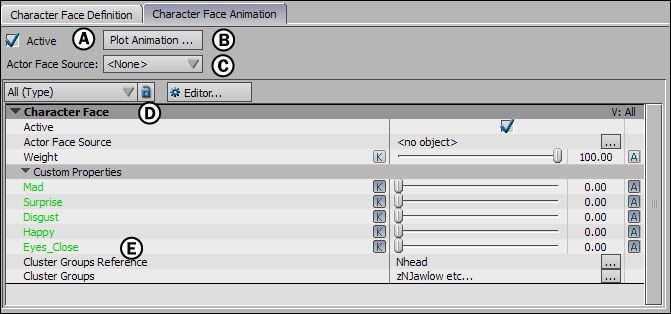Use the Character Face Animation pane to animate the generic and custom expressions defined in the Character Face Definition pane.
The Character Face Animation pane lets you animate using keyframes, motion capture, and constraints.

Character Face Animation pane A. Active option B. Plot Animation button C. Actor Face Source D. Character Face Properties E. Actor Face Properties
The Character Face Animation pane consists of the following:
To activate and constrain the Character Face to either an Actor Face or plotted animation, enable the Active option. You can also enable the Active option in the Character Face Definition pane.
When Active is enabled, you cannot preview facial expressions on the model in the Viewer window. You are also unable to define shapes.
The Plot Animation button lets you transfer the animation from the selected source to the shapes of the Character Face model. See Plotting facial animation.
The Actor Face Source menu, lets you select an Actor Face as the animation source.
An Actor Face lets you use motion capture data as a source for your Character Face. The motion capture data can be from live sensors connected to a performer or an imported motion data file. See Connecting an Actor Face to motion capture data.
The View menu gives two methods of viewing generic channels:
All custom expressions display as properties that you can keyframe and animate in the Character Face Properties area.
Once all the animation is plotted to the model, you can save your .fbx file and import it into other compatible 3D software, or reuse it in MotionBuilder. You can also see the function curves on the animation in the FCurves window.
If the Character Face uses an Actor Face as its source, an additional folder with all the Generic channels appears.